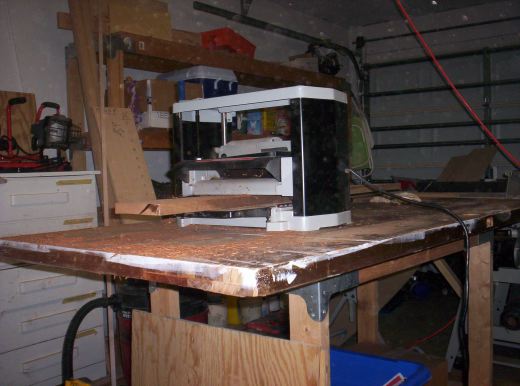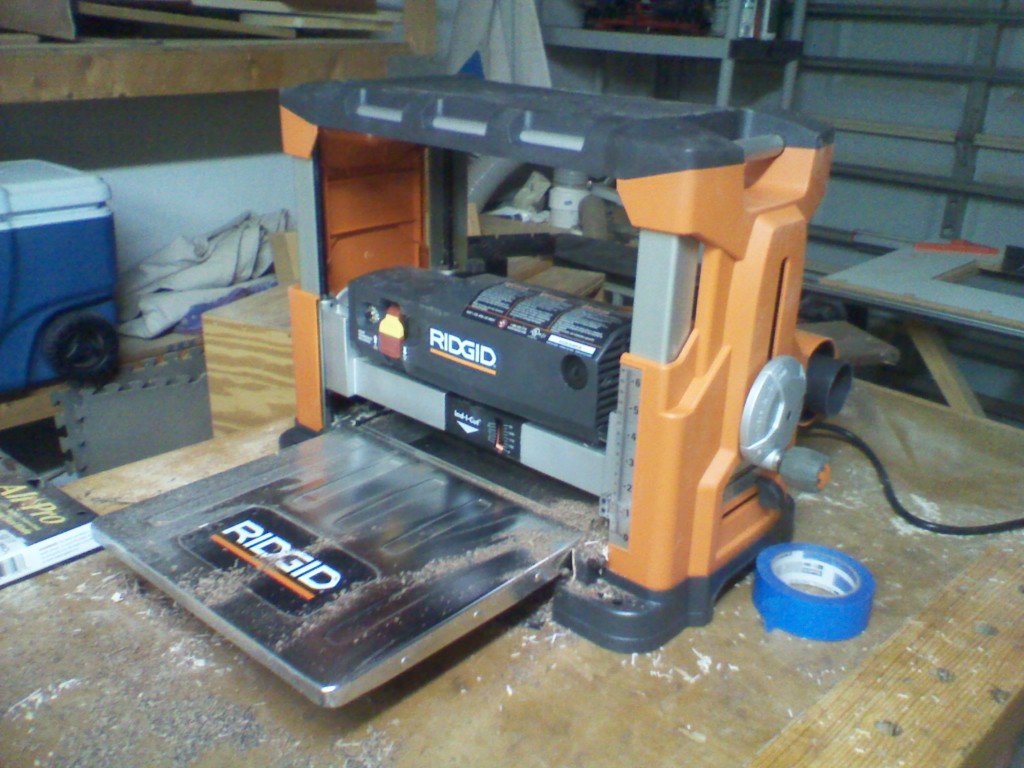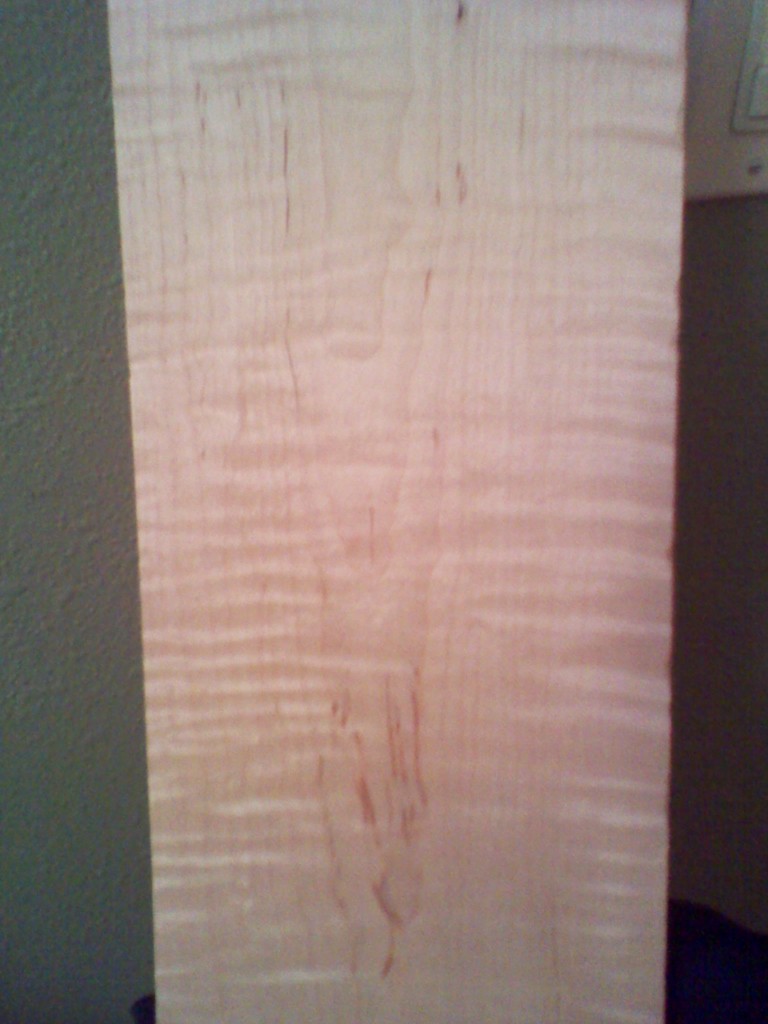I have to confess… I love milling lumber. It’s so cool to peel off a layer of rough wood to see what lies beneath. But I have grown tired of my Delta planer. It’s OK, and it has served me well for years, but its performance has been – how shall I put it – lousy.
It seems to work very well with straight-grained, thick hardwoods. It can plane those all day, leaving a bit of a divot at the rear, but better than satisfactory everywhere else. But, get that wood thin or figured and it’s Katie bar the door. I’ve seen rough board surfaces turn into moonscapes of tear out and snipe marks everywhere. Just awful.
There are plenty of tricks out there about how to reduce this nastiness. Build an extension board. Check. Take very light passes. Check. Moisten the top of the board before planing. Check. Push it through on an angle. Check. And, none of these tips worked. At all.
So, last night, when I got home from work, I decided the time was right to take the plunge. I grabbed up all the Home Depot gift cards I got for the holidays and trucked on down the road to big orange. There, I bought the latest and greatest Ridgid planer – the model R4330 thickness planer.
Why this model? Well, first of all, I’ve had a lot of success with Ridgid tools – my spindle sander, miter saw and table saw are all nice and orange. This model also has a three blade cutterhead – and, from what I read, that gives a better result than the two blade cutters. It has the Indicut control, which shows me when the cutterhead assembly contacts the board and how much material I’m taking off. Plus, I can’t get enough of the built-in dust collection. I hate shoveling the shavings after I plane boards with my Delta – they get everywhere.
I had fun loading it into my Corolla, and I hauled it to the shop with some help from my son Dominic. The assembly was very easy, consisting of putting together the dust collection shroud and the height adjustment handle. The fit and finish of the tool was very nice, and I loved the features such as on board tool storage for assembly and blade changes as well as a convenient cord wrap.
Sure, I should have read all of the directions carefully before I began, but DUDE, I needed to try it out! So, I plugged it in and took some curly maple I had resawn and attempted to plane on the Delta (Boy, was that a bad idea). I figured that the pieces may already be a total loss, so what was there to lose?
I set the cutterhead to where it just kissed the board’s top and turned the motor on. I carefully fed the board through, and it slid right under the knives. OK, maybe a little lower next time. And, I could hear the knives just graze the board’s rough top. Another pass, and more knife contact. Soon, I was removing the ugliness of the previous night’s attempt, and things were looking good. And, I mean REALLY good.
So good, in fact, that I believe that sanding these curly maple panels would ruin the very nice surface I put on them! I didn’t think it was possible to get this kind of smoothness straight from the planer, but wow, I was totally impressed. And, yes, that board is 1/4″ thick… with that kind of smooth surface on it. Unreal.
The planer does fold up into roughly the same sized footprint of the Delta, so stowage shouldn’t be an issue. With this new planer, I think I can get over my phobias and start looking forward to getting more use out of the tool.




I have to say that it’s good to hear that I’m not the only one with the same problem Tom. I have the same Delta planer as you. I also tried all the things that you mentioned to get decent results, and none of them worked. I’m convinced now! Thanks for the review. The Rigid planer just moved to the top 3 on my wish list!
Tom – awesome! To keep the great results you see now, keep the blades sharp. I can’t believe the results I got from my jointer when I first ran a board. Not quite so great now with dull blades, and more tear-out. So certainly some of that is the sharp blades – just a note!
My DELTA planer has been just OK – but every time I think about upgrading I think about all the other things I want too 😉 Heh. More of my problem is the storage issue – I hate pulling it out and want a more permanent type solution (or at least much easier to get out / put away).
Oh, don’t I know it! I’ll definitely ride herd on those blades.
I’m sure I could have spent more time on tuning up the Delta, but the Ridgid comes with built in dust collection, the cut depth indicator, three blades, it’s quieter and it doesn’t leave any snipe… For that alone, it was worth the upgrade.
If you have Understanding Wood, there’s a bit in there about planing and feed rates. It says that for high cuts / inch (more than … 8? I think most lunchboxes do 75 ~ 150!), the blades have to be super sharp, otherwise you’ll have issues. Was a bit surprised when I stumbled over that.
“So good, in fact, that I believe that sanding these curly maple panels would ruin the very nice surface I put on them!”
But, just to be sure, you ARE going to sand it, right, Tom? Have yet to see a board come off of a planer that doesn’t need sanding to get the scallops out. I see it all the time in projects at the local woodworking meetings – people think the cut straight off the planer or router is good enough and so they don’t sand or scrape or plane it any further. But if you put it in the right light (not difficult), you see hundreds of perfectly even minute ridges from the router bit or planer blades.
Sand? Bite yer tongue, laddy boy! I’m gonna hit ’em with the Veritas smooth plane. 🙂
Are you sure you just haven’t missed a belt to tighten on the Delta planer? #OdeToTheBandSaw
First freakin’ thing I checked! 😉
Hi Tom,
Speaking of Ridgid tools, this post reminds me that I’ve been meaning to ask you about your bandsaw. I beleive we both have the same Ridgid BS1400 bandsaw and I seem to recall that you had an ephiphay regarding your saw some time ago. I’ve been frustrated at the apparent lack of power my saw has when it comes to resawing. What size/TPI?brand of blade do you use in your saw and what did you do to get it working better?
Jason – No, I don’t have a Ridgid band saw… instead, I have a Delta. And, yes, I discovered that I didn’t have the drive belt tight enough, which meant that the power stunk on the saw.
http://tomsworkbench.com/2011/01/21/dear-band-saw/
I know that Michael Fortune uses a Ridgid band saw for a lot of his work.. and he says it has plenty of power. Maybe you have the same problem I had.
For resawing, I’m using an Olsen 3 tpi skip tooth 5/8″ blade. The thing is enormous, and it cuts straight. I was plowing through a six inch wide piece of tiger maple over the weekend… it was awesome.
Hey Mike,
Try this for your planer storage issue. I think I got the design from a ShopNotes magazine if I remember right.
http://www.thewoodninja.com/wp-content/uploads/2011/10/DSC01274.jpg
You will enjoy it Tom! I picked up the Dewalt model sitting right beside of it…why well they had a special for $50 off. Very similar though and I love mine.
ahhh, the first new tool for 2012 in the Iovino shop!
Life is good!
(think I might need a cigarette…)
Just keep Iggy’s tail away from the in-feed table! lol
Tom: I have the same model planer for over a year and have had really good success with it!!
Eric – Indeed – life is good. And, I’ll have words with that monkey of mine…
Welcome to the club Tom. I always hear about the stories of struggles people have with their planners. The first planner I ever owned was the ridgid and It’s still an important tool in my shop after 5 years. I never have any problems at all with it, even with curly maple. I just built a hall table from Curly Maple and all the wood needed to be planed to thickness. I had no issues at all. Combine that with the lifetime warranty, and you just couldn’t get me to part with my Ridgid Planner.
There is a LOT to be said about that lifetime warranty….
I’m still using one of the first Ryobi 10″ planers, and it’s got to die eventually (doesn’t it?), so I’m interested in all things planer-related. I’ll look forward to seeing how this one holds up.